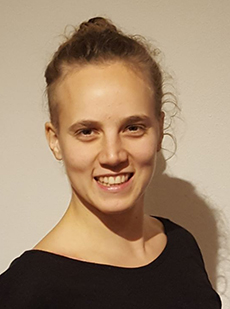Margaux Aubel

Molecular Evolution and Bioinformatics
Institute for Evolution and Biodiversity
University of Münster
Hüfferstr. 1
48149 Münster, Germany
Phone: +49 251/83-21633
m.aubel@uni-muenster.de
Nationality: German 
How do new proteins come about? De novo emergence and ancestor reconstruction as a route to novel proteins
Proteins are the key components of all forms of life. For many years, researchers have assumed that the majority of new proteins arise after the duplication and mutation of established proteins. But recent research shows that new proteins can arise by emergence of de novo genes from previously non-coding DNA. These de novo proteins have become the subject of more recent studies, but many questions remain unanswered. Little is known about what de novo proteins look like and if they have a defined structure or are mostly disordered. Some de novo genes have been assigned a function or structure but large pools of candidate de novo proteins remain unncharacterised.
In my thesis, I want to investigate de novo proteins and their properties. I will compare a library of random sequences with candidate de novo protein sequences from human and fruit fly (Drosophila melanogaster) using a Förster Resonance Energy Transfer (FRET) based assay. The sequences will be sorted on their ability to fold by Fluorescence Activated Cell Sorting (FACS).
I will express and purify single de novo proteins from human and fruit fly (Drosophila melanogaster). Then, I will reconstruct ancestral protein sequences, i.e. the most likely sequences the de novo proteins had upon birth, from these purified de novo proteins. Ancestral and extant proteins can then be compared structurally and concerning their binding patterns to understand if and how they have adapted and changed structure and/or function. Structural characterisation will be done by prediction algorithms, molecular dynamics simulations (MD), thermal shift assay (TSA) and circular dichroism (CD). Since
binding to other proteins is likely to be the most accessible function of novel proteins, I will analyse the binding pattern of de novo proteins and their ancestors using proteomic peptide phage display. To understand changes between ancestral and extant proteins, I will perform all analyses on both protein types.
Aubel M, Eicholt L, Bornberg-Bauer E (2023) Assessing structure and disorder prediction tools for de novo emerged proteins in the age of machine learning. F1000Research 12:347. 10.12688/f1000research.130443.1 [doi]
Aubel M, Bornberg-Bauer E (2023) Introducing creative destruction as a mechanism in protein evolution. Proceedings of the National Academy of Sciences of the United States of America 120(6):e2220460120. 10.1073/pnas.2220460120 [doi]
Eicholt LA, Aubel M, Berk K, Bornberg-Bauer E, Lange A (2022) Heterologous expression of naturally evolved putative de novo proteins with chaperones. Protein Science 31(8):e4371. 10.1002/pro.4371 [doi]